The harmonic emissions of DFIG mainly consist of three parts: (i) the inherent harmonics; (ii) the switching harmonics; and (iii), the harmonics induced by the unbalance conditions or the background harmonic voltage.
Figure 3.
The topological diagram of DFIG.
The harmonics emissions named non-characteristic harmonics and caused by nonsinusoidal distribution and disturbed operation conditions, are nonlinear and variable. Papathanassiou, Tentzerakis and Sainz studied the harmonic emissions of practical wind turbines in references [
12,
13,
31], and drew two important conclusions: (i) the influence of a wind farm operating point on harmonic current is small, and the pdfs of
hth harmonic currents do not change significantly from one power level to another; (ii) the fifth and seventh harmonics are the dominant components, and the total harmonic current distortion mainly depends on them, so the low order harmonics are the main components of non-characteristic harmonics. In this paper the fifth and seventh harmonics are researched in depth, and the proposed models are also valid for other low order harmonic emissions. This paper focuses on the evaluation of the non-characteristic and switching harmonic emissions of a small-scale wind farm. The orders of the non-characteristic harmonics are the fifth and seventh, and the order of the switching harmonic is affected by the switching frequency.
2.2.1. Low Order Non-Characteristic Harmonics
When the fifth harmonic current is analyzed, the steady state circuit of DFIG is in negative sequence. The parameters in
Figure 2 are calculated as follows:
N = −1,
ωs = 5
ωe,
fs = 5
fe,
fr =
fs +
fm = 5
fe + (1 −
s)
fe = (6 −
s)
fe,
.
When the seventh harmonic current is analyzed, the steady state circuit of DFIG is in positive sequence. The parameters in
Figure 2 are calculated as follows:
N = 1,
ωs = 7
ωe,
fs = 7
fe,
fr =
fs −
fm = 7
fe − (1 −
s)
fe = (6 +
s)
fe,
.
s = (fe − fm)/fe > 0 represents sub-synchronous operating status; s = (fe − fm) / fe < 0 represents super-synchronous operating status.
Due to the stochastic and variable non-characteristic harmonic emissions, the probability methodology is utilized.
is set as a random harmonic phasor. If the pdfs of
Xh and
Yh can be approximated by Gaussian distributions, the joint probability distribution functions of
Xh and
Yh will agree with Equation (3):
where:
![Energies 06 03297 i005]()
,
rXhYh is the correlation coefficient of
Xh and
Yh,
μXh and
μYh are the mean values,
σXh and
σYh are the standard deviation values.
The pdfs of
Ih and
ϕh are given by Equation (4):
Traditional Rayleigh distribution, Bessel function, and Rician distribution are all derived from Equation (4), in the hypothesis that the pdfs of
Xh and
Yh can be approximated by Gaussian distributions [
32]. The hypothesis is important to study the harmonic propagation and summation [
33].
For a large-scale wind farm, the number of wind power generators is large enough to ensure the Gaussian hypotheses of
Xh and
Yh based on the central limit theorem, but for a small-scale wind farm, the number of wind power generators is limited, and the probability distribution of the non-characteristic low order harmonic may not be the normal distribution [
13,
31].
If the probability distribution function (pdf) of the harmonic emission becomes complex, the harmonic propagation and interaction analysis will be difficult. In this paper, Generalized Gamma Mixture Models are proposed to study the probability distributions of non-characteristic harmonics. And GGMM consist of the Gaussian mixture models, improved phasor clustering and generalized Gamma models.
(i) Gaussian mixture models
Gaussian mixture models (GMMs) can accurately approach the non-negative Riemann integral functions such as different pdfs by dividing the complicated pdfs into several simplified Gaussian distributions [
34]. GMMs are fitted with Equation (5):
where:
; and M is the order of GMM;
εm is the weighted coefficient;
ϕm(
x) is the
m-th Gaussian distribution with mean value
μm and variance value
.
are the parameters of GMM, and can be estimated by expectation maximization (EM) method [
35,
36].
(ii) Improved phasor clustering models
After step (i), the pdfs of
Xh and
Yh can be divided into several Gaussian components:
But the pdf of harmonic phasor amplitude is determined by
Xh,
Yh and their correlation coefficient. If
rXhYh = 0, the pdf of harmonic phasor amplitude can be given by Equation (7):
But if
rXhYh ≠ 0, Equation (7) is not adequate. The optimal phasor clustering method which can obtain the inherent characteristic of harmonic phasors is proposed to solve the correlation problem. Reference [
3] divides the harmonic phasors based on the shortest distance away from the central phasors. In this paper, the harmonic phasors are clustered by the whole distribution characteristic.
Firstly, the central phasors are defined as (μxm, μyn) based on Cartesian axes, and their dimension is m × n. μxm and μyn are the mean values of Xh and Yh based on step (i).
Then the vector space is divided into several regions according to the statistical properties of the Gaussian components in step (i). If the division rule is the shortest distance away from the central phasors, the variance characteristic will be ignored, so the optimal phasor clustering method divides the vector space by the intersection among the Gaussian components.
For example, the pdf of a phasor’s X component is combined by two Gaussian functions,
N(0,1) and
N(10,5). The intersection point is (2.3, 0.025), as shown in
Figure 4a.
x = 2.3 is set as the first division axis. The pdf of Y component is just the same, and
y = 2.3 is the second division axis.
x = 5 and
y = 5 are the division axis under the shortest distance rule. The harmonic phasors between
x = 2.3 and
x= 5 should belong to the
N(10,5) part, so the shortest distance rule is not adequate. Furthermore, the divided regions are presented in
Figure 4b. The optimal phasor clustering method contains the whole probability property of harmonic phasors.
After phasor clustering, the pdfs of
Xh and
Yh in each cluster can be approximated by Gaussian distribution. So if
rXhYh ≠ 0, the pdf of harmonic phasor amplitude based on phasor clustering can be given by Equation (8):
Figure 4.
Verification of the optimal phasor clustering. (a) Pdf and division axis of X component; (b) Comparison of two clustering method.
Figure 4.
Verification of the optimal phasor clustering. (a) Pdf and division axis of X component; (b) Comparison of two clustering method.
(iii) Generalized Gamma models
After step (i) and (ii), the pdf of harmonic currents can be given by Equations (7,8). And the complicated pdf is divided into the ideal functions like fm,n(x + jy) or fk(x + jy) which can be approximated by GGD due to the pdfs of Xh and Yh in each cluster agree with Gaussian distributions.
GGD with two parameters is given by Equation (9):
where:
![Energies 06 03297 i011]()
;
;
.
According to the above three steps, any kind of pdfs of harmonic phasors can be approximated by GGMM. And if the pdfs of X and Y are just fitted with Gaussian distribution, GGMM will be directly modeled by step (iii).
2.2.2. High Order Switching Harmonics
High order switching harmonics of DFIG with PWM controllers consist of two parts: the harmonic emission of the grid-side converter is directly injected into the grid system; the harmonic produced by the rotor-side converter intertwine through the electromagnetic coupling between the stator and rotor, and then is injected into the power grid through the stator.
The switching frequencies of the rotor-side and grid-side converters are set as
frc and
fgc. And the harmonic voltage of the grid-side converter is calculated by Equation (10) [
37]:
where
M is the modulation index amplitude; and
Vdc is the DC side voltage. Normally,
Vdc is constant by the optimal control strategy of the grid-side converter. Then the amplitude of the output harmonic voltage is determined by
M.
As the fundamental frequency of the grid-side converter is
fe = 50 Hz, the switching harmonic orders of the grid-side converter contain:
fgc ± 2
fe,
fgc ± 4
fe, 2
fgc ±
fe, 2
fgc ± 5
fe, 2
fgc ± 7
fe, 3
fgc ± 2
fe, 3
fgc ± 4
fe… [
38,
39]. When the switching frequency is quite high (thousands of Hz),
fgc ± 2
fe is the only harmonic order we need to consider. Other switching frequencies are ignored due to their small amplitude.
On the other hand, the control strategy of DFIG is constant frequency with variable speed. The reference frequency of the rotor-side converter is |sfe|. Then the switching harmonic emissions of the rotor-side converter are injected into the grid through the air gap magnetic field between the stator and rotor.
Similar to the harmonic emissions of the grid-side converter, the switching harmonic order of the rotor-side converter is frc ± 2|sfe|.
If frc ± 2|sfe| = (6m + 1)|sfe|,
fs = fr + fm = frc ± 2|sfe| + (1 − s)fe, ;
If frc ± 2|sfe| = (6m − 1)|sfe|,
fs = fr − fm = frc ± 2|sfe| − (1 − s)fe, .
According to the steady state of DFIG in
Figure 2,
Vsh = 0 if there aren’t any background harmonics, the switching harmonic current emissions are affected by
,
and
slip. But the switching harmonic current emissions of the grid-side converter are only related to the output harmonic voltage.
Non-characteristic and switching harmonic emissions of DFIG are discussed in this section. In order to study the harmonic propagation, the harmonic source model of DFIG is given in
Figure 5. It consists of three parts: induction motor model is based on
Figure 2; harmonic source part is the non-characteristic or switching harmonic emissions; auxiliary load is the supply load in the wind farm, and it can also be compensation devices.
Figure 5.
The diagram of the harmonic source model of DFIG.
Figure 5.
The diagram of the harmonic source model of DFIG.

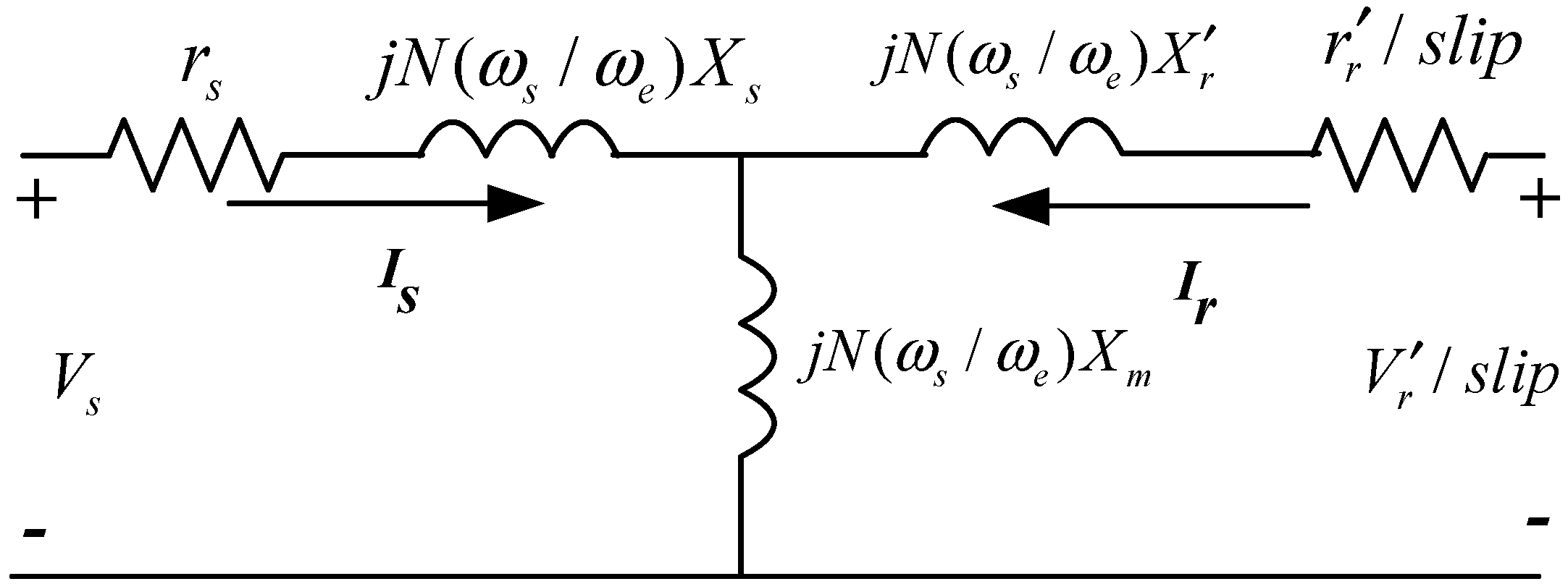



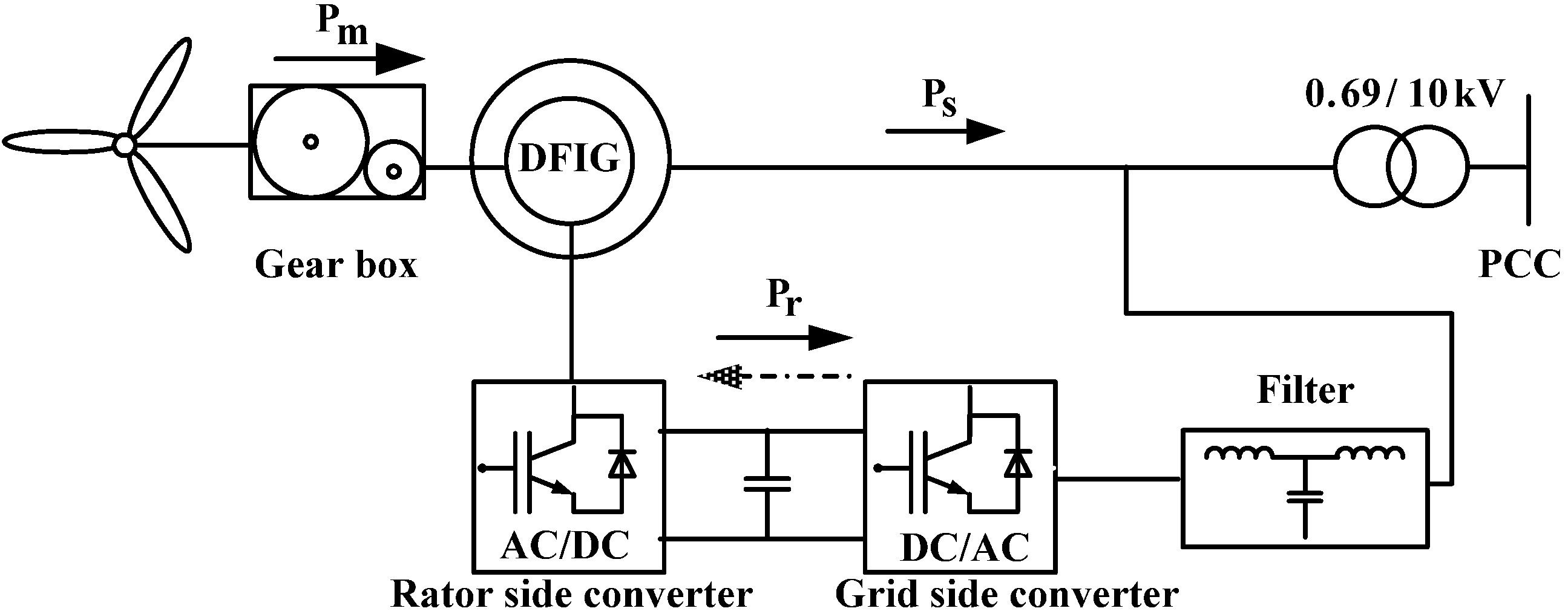

 , rXhYh is the correlation coefficient of Xh and Yh, μXh and μYh are the mean values, σXh and σYh are the standard deviation values.
, rXhYh is the correlation coefficient of Xh and Yh, μXh and μYh are the mean values, σXh and σYh are the standard deviation values.





 ; ; .
; ; .

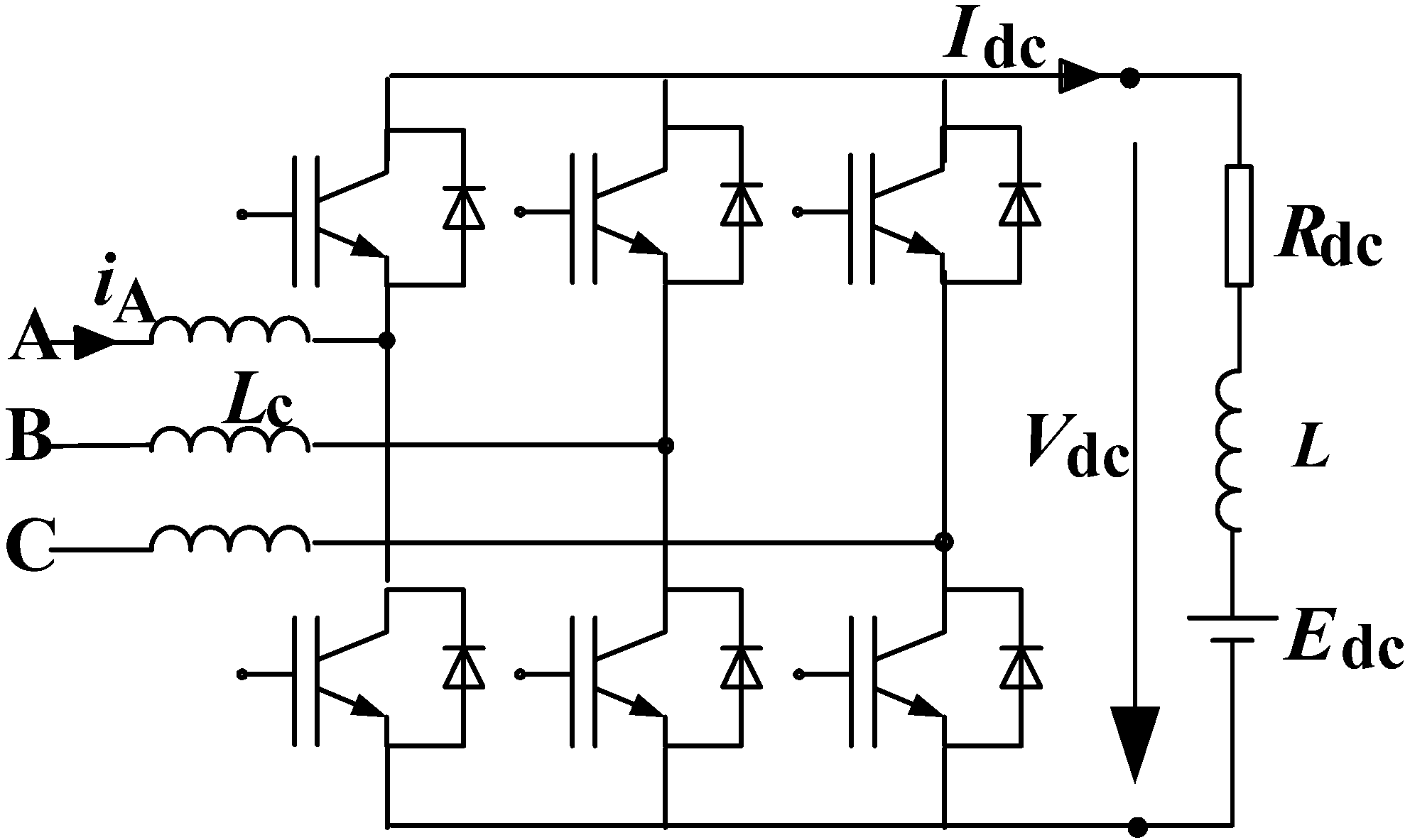


 ; the subscript i means the number i converter, the matrix parameters , are given by Equations (14–16):
; the subscript i means the number i converter, the matrix parameters , are given by Equations (14–16):





 and Ih_wind reflect the harmonic characteristic of nonlinear converters and wind farm.
and Ih_wind reflect the harmonic characteristic of nonlinear converters and wind farm. and then Equation (18) is transformed into Equation (19):
and then Equation (18) is transformed into Equation (19):


 .
.

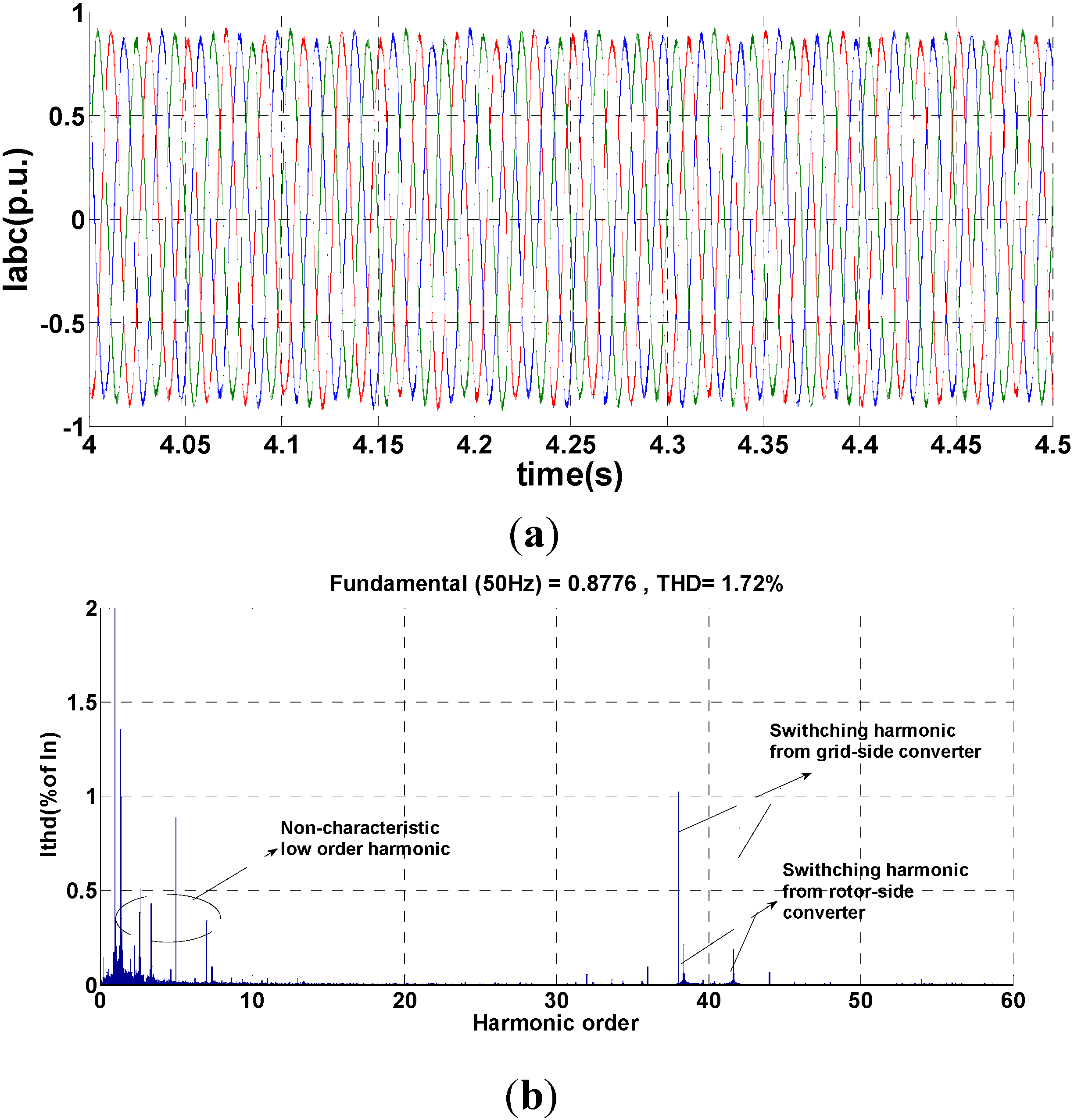
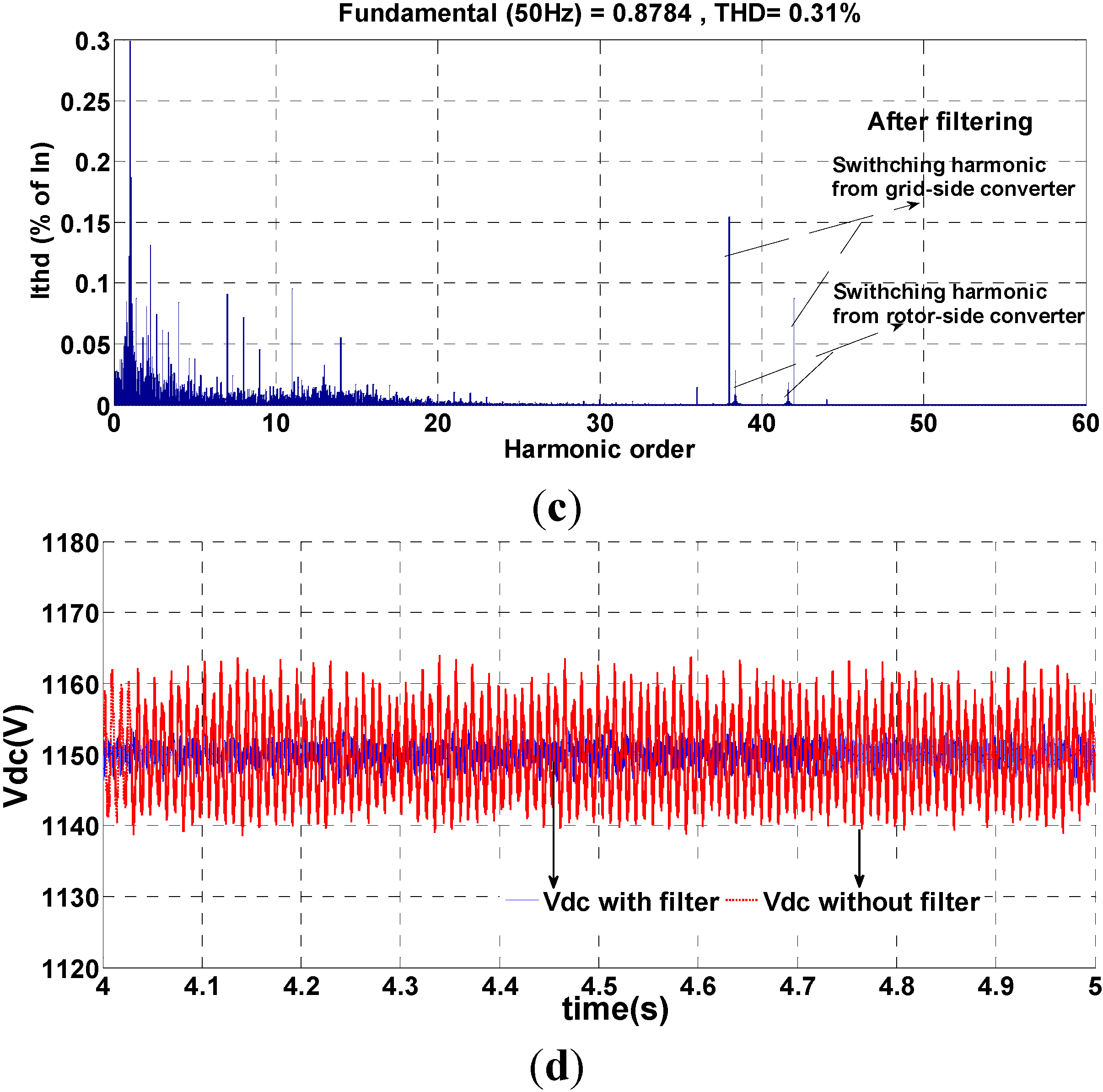




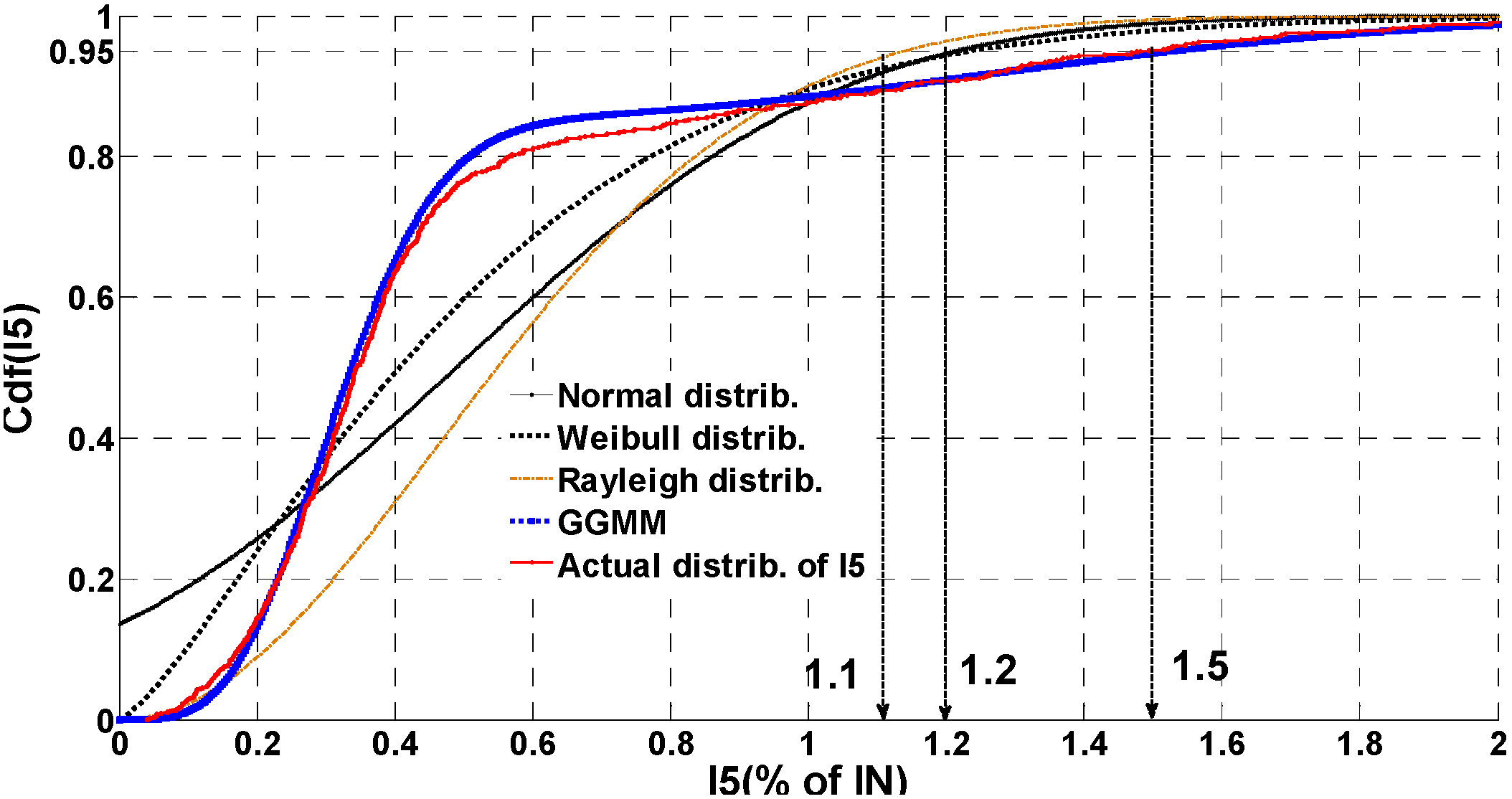

 represents the harmonic propagation of nonlinear loads,
represents the harmonic propagation of nonlinear loads,  represents the wind harmonic propagation.
represents the wind harmonic propagation.






